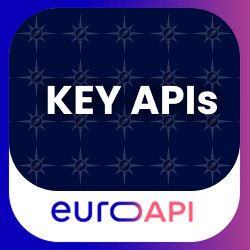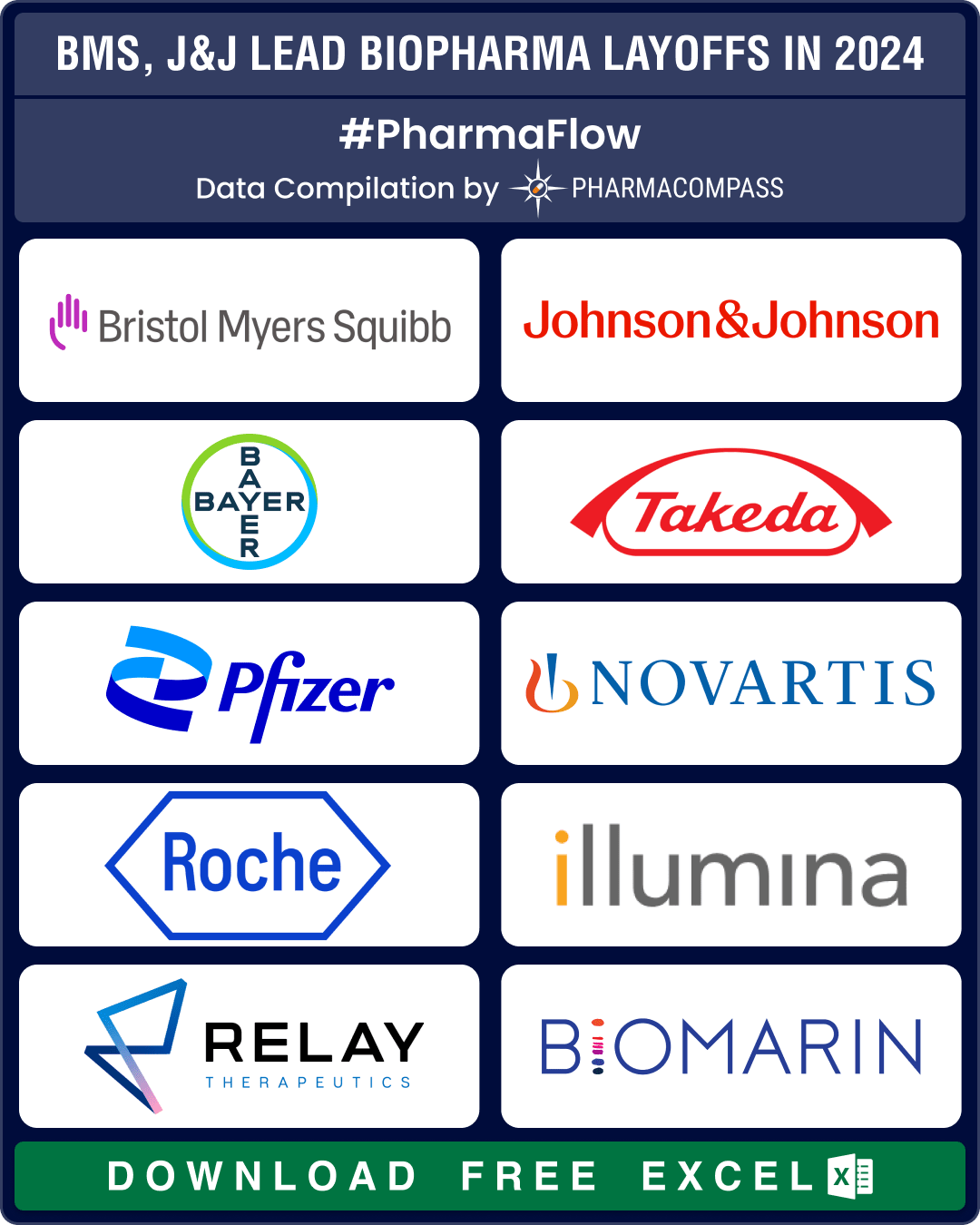01 Apr 2025
// PRESS RELEASE
03 Mar 2025
// PRESS RELEASE
30 Jan 2025
// PRESS RELEASE
Latest Content by PharmaCompass
 KEY PRODUCTS
KEY PRODUCTS KEY SERVICES
KEY SERVICES
EUROAPI, the leading small molecules API player, provides both API sales & CDMO services.
About
CPhI North America CPhI North America
Industry Trade Show
Booth #1212
20-22 May, 2025
Industry Trade Show
Attending
19-22 May, 2025
Industry Trade Show
Attending
11-12 June, 2025
CONTACT DETAILS





Events
Webinars & Exhibitions
CPhI North America CPhI North America
Industry Trade Show
Booth #1212
20-22 May, 2025
Industry Trade Show
Attending
19-22 May, 2025
Industry Trade Show
Attending
11-12 June, 2025
CORPORATE CONTENT #SupplierSpotlight
https://www.pharmacompass.com/radio-compass-blog/bms-j-j-bayer-lead-25-000-pharma-layoffs-in-2024-amylyx-fibrogen-kronos-bio-hit-by-trial-failures-cash-crunch
https://www.pharmacompass.com/radio-compass-blog/cdmo-activity-tracker-bora-polpharma-make-acquisitions-evonik-euroapi-porton-announce-technological-expansions
https://www.pharmacompass.com/radio-compass-blog/chinese-fda-registered-generic-facilities-gain-steam-india-maintains-lead-with-396-facilities
https://www.pharmacompass.com/radio-compass-blog/us-europe-turn-to-advanced-manufacturing-stockpiling-to-strengthen-drug-supply-chains
https://www.pharmacompass.com/radio-compass-blog/bms-bayer-takeda-pfizer-downsize-to-combat-cost-pressures-meet-restructuring-plans
https://www.pharmacompass.com/radio-compass-blog/cdmo-activity-tracker-novo-s-parent-buys-catalent-for-us-16-5-bn-fujifilm-merck-kgaa-axplora-lonza-expand-capabilities
https://www.pharmacompass.com/radio-compass-blog/fda-approves-four-oligonucleotide-therapies-in-2023-novartis-gsk-novo-bet-big

01 Apr 2025
// PRESS RELEASE
https://www.euroapi.com/sites/default/files/2025-04/euroapi-press-release-april-1-2025.pdf

03 Mar 2025
// PRESS RELEASE

30 Jan 2025
// PRESS RELEASE
https://www.euroapi.com/en/euroapi-and-strainchem-enter-into-collaboration-for-liquid-phase-peptides

06 Jan 2025
// PRESS RELEASE
https://www.euroapi.com/en/euroapi-welcomes-the-french-minister-for-health-and-access-to-healthcare-and-the-french-minister-for-industry-and-energy-to-its-puy-de-dome-site

10 Dec 2024
// PRESS RELEASE
https://www.euroapi.com/en/euroapi-moves-into-a-new-chapter-with-new-governance-and-leadership

09 Dec 2024
// PRESS RELEASE
https://www.euroapi.com/en/euroapi-moves-into-a-new-chapter-with-new-governance-and-leadership
 Click Us!
Click Us! 
GDUFA
DMF Review : N/A
Rev. Date :
Pay. Date :
DMF Number : 10948
Submission : 1994-06-20
Status : Active
Type : II

Certificate Number : R1-CEP 2015-302 - Rev 00
Issue Date : 2022-01-31
Type : Chemical
Substance Number : 1488
Status : Valid

Registration Number : 220MF10064
Registrant's Address : To(´) utca 1-5. , 1045 Budapest, Hungary
Initial Date of Registration : 2008-02-25
Latest Date of Registration :

NDC Package Code : 82231-101
Start Marketing Date : 2014-10-28
End Marketing Date : 2025-12-31
Dosage Form (Strength) : POWDER (1g/g)
Marketing Category : BULK INGREDIENT

Registrant Name : Samoh Pharmaceutical Co., Ltd.
Registration Date : 2023-02-02
Registration Number : 20230202-210-J-1440
Manufacturer Name : EUROAPI Hungary Ltd.
Manufacturer Address : To utca 1-5., Budapest, 1045, Hungary

| Available Reg. Filing : CN |

GDUFA
DMF Review : Reviewed
Rev. Date : 2013-02-27
Pay. Date : 2013-02-13
DMF Number : 18340
Submission : 2005-05-09
Status : Active
Type : II

Certificate Number : R1-CEP 2004-314 - Rev 01
Issue Date : 2022-02-08
Type : Chemical
Substance Number : 1974
Status : Valid

Registration Number : 218MF10337
Registrant's Address : Brueningstrasse 50, 65926 Frankfurt am Main, Germany
Initial Date of Registration : 2006-03-09
Latest Date of Registration :

NDC Package Code : 82348-103
Start Marketing Date : 2020-07-01
End Marketing Date : 2025-12-31
Dosage Form (Strength) : POWDER (1kg/kg)
Marketing Category : BULK INGREDIENT

GDUFA
DMF Review : Reviewed
Rev. Date : 2013-09-28
Pay. Date : 2013-09-18
DMF Number : 1748
Submission : 1971-06-21
Status : Active
Type : II

Certificate Number : CEP 1996-019 - Rev 09
Issue Date : 2024-04-12
Type : Chemical
Substance Number : 388
Status : Valid

Registration Number : 218MF10376
Registrant's Address : 15 rue Traversie(')re 75012 Paris France
Initial Date of Registration : 2006-03-20
Latest Date of Registration :

NDC Package Code : 82298-110
Start Marketing Date : 2011-02-07
End Marketing Date : 2025-12-31
Dosage Form (Strength) : POWDER (1kg/kg)
Marketing Category : BULK INGREDIENT

Registrant Name : AbbVie Korea Inc.
Registration Date : 2023-07-03
Registration Number : 20230405-209-J-1469(A)
Manufacturer Name : EUROAPI France
Manufacturer Address : 4 La Paterie, Vertolaye, 63480, France

GDUFA
DMF Review : N/A
Rev. Date :
Pay. Date :
DMF Number : 2789
Submission : 1976-11-11
Status : Active
Type : II

Certificate Number : R1-CEP 2012-163 - Rev 01
Issue Date : 2021-12-16
Type : Chemical
Substance Number : 335
Status : Valid

Registration Number : 220MF10093
Registrant's Address : 15 rue Traversie(')re 75012 Paris France
Initial Date of Registration : 2008-03-28
Latest Date of Registration :

NDC Package Code : 82298-101
Start Marketing Date : 2011-02-07
End Marketing Date : 2025-12-31
Dosage Form (Strength) : POWDER (1kg/kg)
Marketing Category : BULK INGREDIENT

Registrant Name : Novartis Korea Ltd.
Registration Date : 2023-07-25
Registration Number : 20230725-209-J-1524
Manufacturer Name : EUROAPI France
Manufacturer Address : 4 Lieu Dit La Paterie, Vertolaye, 63480, France

| Available Reg. Filing : ASMF |

GDUFA
DMF Review : Reviewed
Rev. Date : 2016-08-04
Pay. Date : 2016-04-08
DMF Number : 30373
Submission : 2016-03-03
Status : Active
Type : II

Certificate Number : CEP 2019-166 - Rev 03
Issue Date : 2024-11-25
Type : Chemical
Substance Number : 335
Status : Valid

Registration Number : 228MF10090
Registrant's Address : 15 rue Traversie(')re 75012 Paris France
Initial Date of Registration : 2016-04-15
Latest Date of Registration :

| Available Reg. Filing : ASMF |

GDUFA
DMF Review : Reviewed
Rev. Date : 2014-03-04
Pay. Date : 2013-02-27
DMF Number : 16152
Submission : 2002-09-25
Status : Active
Type : II

Certificate Number : CEP 2001-179 - Rev 09
Issue Date : 2024-08-01
Type : Chemical
Substance Number : 913
Status : Valid

Registration Number : 218MF10374
Registrant's Address : 82 Avenue Raspail 94250 Gentilly France
Initial Date of Registration : 2006-03-20
Latest Date of Registration :

NDC Package Code : 82298-920
Start Marketing Date : 2015-02-01
End Marketing Date : 2025-12-31
Dosage Form (Strength) : POWDER (1g/g)
Marketing Category : BULK INGREDIENT

GDUFA
DMF Review : Reviewed
Rev. Date : 2014-02-14
Pay. Date : 2013-02-13
DMF Number : 23600
Submission : 2010-03-03
Status : Active
Type : II

Certificate Number : R1-CEP 2009-340 - Rev 02
Issue Date : 2021-12-09
Type : Chemical
Substance Number : 922
Status : Valid

Registration Number : 222MF10169
Registrant's Address : Brueningstrasse 50, 65926 Frankfurt am Main, Germany
Initial Date of Registration : 2010-06-08
Latest Date of Registration :

NDC Package Code : 82348-102
Start Marketing Date : 2010-07-27
End Marketing Date : 2025-12-31
Dosage Form (Strength) : POWDER (1kg/kg)
Marketing Category : BULK INGREDIENT

GDUFA
DMF Review : Reviewed
Rev. Date : 2013-09-11
Pay. Date : 2013-01-16
DMF Number : 26728
Submission : 2012-12-14
Status : Active
Type : II

Certificate Number : R0-CEP 2021-352 - Rev 00
Issue Date : 2022-12-02
Type : Chemical
Substance Number : 2230
Status : Valid

Registration Number : 225MF10111
Registrant's Address : To(´) utca 1-5. , 1045 Budapest, Hungary
Initial Date of Registration : 2013-05-30
Latest Date of Registration :

Registrant Name : Samil Pharmaceutical Co., Ltd.
Registration Date : 2022-10-18
Registration Number : 20221018-211-J-1382
Manufacturer Name : EUROAPI Hungary Ltd.
Manufacturer Address : To utca 1-5., Budapest, 1045, Hungary

| Available Reg. Filing : ASMF |

GDUFA
DMF Review : Reviewed
Rev. Date : 2014-01-14
Pay. Date : 2014-01-06
DMF Number : 2922
Submission : 1977-05-02
Status : Active
Type : II

Certificate Number : R1-CEP 2005-228 - Rev 03
Issue Date : 2021-12-17
Type : Chemical
Substance Number : 1131
Status : Valid

Registration Number : 220MF10128
Registrant's Address : 82 Avenue Raspail 94250 Gentilly France
Initial Date of Registration : 2008-05-15
Latest Date of Registration :

NDC Package Code : 82298-109
Start Marketing Date : 2011-02-07
End Marketing Date : 2025-12-31
Dosage Form (Strength) : POWDER (1kg/kg)
Marketing Category : BULK INGREDIENT

| Available Reg. Filing : ASMF |

GDUFA
DMF Review : Reviewed
Rev. Date : 2013-02-15
Pay. Date : 2013-01-23
DMF Number : 23142
Submission : 2009-09-30
Status : Active
Type : II

Certificate Number : CEP 1996-050 - Rev 07
Issue Date : 2024-02-22
Type : Chemical
Substance Number : 729
Status : Valid

Registration Number : 218MF10971
Registrant's Address : 82 Avenue Raspail 94250 Gentilly France
Initial Date of Registration : 2006-12-01
Latest Date of Registration :

Registrant Name : Korea Mundi Pharma Co., Ltd.
Registration Date : 2013-06-14
Registration Number : 20130507-176-I-164-01(1)
Manufacturer Name : Sanofi Winthrop Industrie
Manufacturer Address : Route d'Avignon 30390 Aramon France

| Available Reg. Filing : CN |
 FULL SCREEN VIEW Click here to open all results in a new tab [this preview display 10 results]
FULL SCREEN VIEW Click here to open all results in a new tab [this preview display 10 results]
Services
API Manufacturing
API & Drug Product Development
Excipients
Excipients by Ingredients
Excipients By applications
Inspections and registrations
ABOUT THIS PAGE
Sanofi Cepia is a supplier offers 142 products (APIs, Excipients or Intermediates).
Find a price of Alprostadil bulk with DMF, CEP, JDMF offered by Sanofi Cepia
Find a price of Clobazam bulk with DMF, CEP, JDMF offered by Sanofi Cepia
Find a price of Dexamethasone bulk with DMF, CEP, JDMF offered by Sanofi Cepia
Find a price of Dexamethasone Sodium Phosphate bulk with DMF, CEP, JDMF offered by Sanofi Cepia
Find a price of Hydrocortisone bulk with DMF, CEP, JDMF offered by Sanofi Cepia
Find a price of Hydroxocobalamin Acetate bulk with DMF, CEP, JDMF offered by Sanofi Cepia
Find a price of Ketoprofen bulk with DMF, CEP, JDMF offered by Sanofi Cepia
Find a price of Latanoprost bulk with DMF, CEP, JDMF offered by Sanofi Cepia
Find a price of Methylprednisolone Hemisuccinate bulk with DMF, CEP, JDMF offered by Sanofi Cepia
Find a price of Naloxone Hydrochloride bulk with DMF, CEP, JDMF offered by Sanofi Cepia
Find a price of Prednisolone bulk with DMF, CEP, JDMF offered by Sanofi Cepia
Find a price of Prednisolone Acetate bulk with DMF, CEP, JDMF offered by Sanofi Cepia
Find a price of Selegiline Hydrochloride bulk with DMF, CEP, JDMF offered by Sanofi Cepia
Find a price of Spironolactone bulk with DMF, CEP, JDMF offered by Sanofi Cepia
Find a price of Vitamin B12 bulk with DMF, CEP, JDMF offered by Sanofi Cepia
Find a price of Apomorphine Hydrochloride bulk with DMF, CEP offered by Sanofi Cepia
Find a price of Bimatoprost bulk with DMF, JDMF offered by Sanofi Cepia
Find a price of Dexamethasone bulk with DMF, CEP offered by Sanofi Cepia
Find a price of Dinoprostone bulk with DMF, JDMF offered by Sanofi Cepia
Find a price of Fexofenadine Hydrochloride bulk with CEP, JDMF offered by Sanofi Cepia
Find a price of Fluorometholone bulk with DMF, JDMF offered by Sanofi Cepia
Find a price of Fluticasone Propionate bulk with CEP, JDMF offered by Sanofi Cepia
Find a price of Glimepiride bulk with DMF, CEP offered by Sanofi Cepia
Find a price of Hydrocortisone Acetate bulk with CEP, JDMF offered by Sanofi Cepia
Find a price of Hydroxocobalamin bulk with DMF, JDMF offered by Sanofi Cepia
Find a price of Irbesartan bulk with DMF, CEP offered by Sanofi Cepia
Find a price of Methylprednisolone bulk with DMF, CEP offered by Sanofi Cepia
Find a price of Naltrexone Hydrochloride bulk with DMF, CEP offered by Sanofi Cepia
Find a price of Prednisone bulk with DMF, CEP offered by Sanofi Cepia
Find a price of Ramipril bulk with DMF, CEP offered by Sanofi Cepia
Find a price of Rifampicin bulk with DMF, JDMF offered by Sanofi Cepia
Find a price of Rifaximin bulk with DMF, JDMF offered by Sanofi Cepia
Find a price of Sevelamer Hydrochloride bulk with DMF, JDMF offered by Sanofi Cepia
Find a price of Sodium Cromoglicate bulk with DMF, CEP offered by Sanofi Cepia
Find a price of Travoprost bulk with DMF, JDMF offered by Sanofi Cepia
Find a price of Alprostadil Alfadex bulk with JDMF offered by Sanofi Cepia
Find a price of Beraprost Sodium bulk with JDMF offered by Sanofi Cepia
Find a price of Bimatoprost bulk with DMF offered by Sanofi Cepia
Find a price of Carboprost Tromethamine bulk with DMF offered by Sanofi Cepia
Find a price of Clobazam bulk with CEP offered by Sanofi Cepia
Find a price of Clopidogrel bulk with JDMF offered by Sanofi Cepia
Find a price of Codeine bulk with CEP offered by Sanofi Cepia
Find a price of Codeine Phosphate bulk with CEP offered by Sanofi Cepia
Find a price of Cortisone bulk with JDMF offered by Sanofi Cepia
Find a price of Desoximetasone bulk with DMF offered by Sanofi Cepia
Find a price of Dexamethasone Sodium Phosphate bulk with JDMF offered by Sanofi Cepia
Find a price of Dinoprost bulk with JDMF offered by Sanofi Cepia
Find a price of Dinoprost Tromethamine bulk with CEP offered by Sanofi Cepia
Find a price of Epoprostenol Sodium bulk with DMF offered by Sanofi Cepia
Find a price of Ethylmorphine Hydrochloride bulk with CEP offered by Sanofi Cepia
Find a price of Glimepiride bulk with CEP offered by Sanofi Cepia
Find a price of Hydrocortisone bulk with JDMF offered by Sanofi Cepia
Find a price of Hydrocortisone Acetate bulk with CEP offered by Sanofi Cepia
Find a price of Hydrocortisone Sodium Succinate bulk with CEP offered by Sanofi Cepia
Find a price of Hydroxocobalamin Acetate bulk with JDMF offered by Sanofi Cepia
Find a price of Hydroxocobalamin Hydrochloride bulk with CEP offered by Sanofi Cepia
Find a price of Hydroxychloroquine Sulphate bulk with DMF offered by Sanofi Cepia
Find a price of Iloprost bulk with DMF offered by Sanofi Cepia
Find a price of Levomepromazine Hydrochloride bulk with JDMF offered by Sanofi Cepia
Find a price of Levomepromazine Maleate bulk with CEP offered by Sanofi Cepia
Find a price of Levomethadone bulk with CEP offered by Sanofi Cepia
Find a price of Limaprost Alfadex bulk with JDMF offered by Sanofi Cepia
Find a price of Morphine Hydrochloride bulk with CEP offered by Sanofi Cepia
Find a price of Morphine Sulfate bulk with CEP offered by Sanofi Cepia
Find a price of Nalbuphine Hydrochloride bulk with DMF offered by Sanofi Cepia
Find a price of Norepinephrine bulk with CEP offered by Sanofi Cepia
Find a price of Norepinephrine Bitartrate bulk with CEP offered by Sanofi Cepia
Find a price of Oxycodone Hydrochloride bulk with CEP offered by Sanofi Cepia
Find a price of Piretanide bulk with CEP offered by Sanofi Cepia
Find a price of Prednicarbate bulk with CEP offered by Sanofi Cepia
Find a price of Prednisolone bulk with CEP offered by Sanofi Cepia
Find a price of Ramipril bulk with DMF offered by Sanofi Cepia
Find a price of Rifamycin Sodium bulk with CEP offered by Sanofi Cepia
Find a price of Teicoplanin bulk with JDMF offered by Sanofi Cepia
Find a price of Tiaprofenic Acid bulk with CEP offered by Sanofi Cepia
Find a price of Treprostinil Sodium bulk with DMF offered by Sanofi Cepia
Find a price of Triamcinolone Acetonide bulk with DMF offered by Sanofi Cepia
Find a price of Vitamin B12 bulk with CEP offered by Sanofi Cepia
Find a price of Zolpidem Tartrate bulk with JDMF offered by Sanofi Cepia
Find a price of Alimemazine bulk offered by Sanofi Cepia
Find a price of Alprostadil bulk offered by Sanofi Cepia
Find a price of Altrenogest bulk offered by Sanofi Cepia
Find a price of Amiodarone Hydrochloride bulk offered by Sanofi Cepia
Find a price of Amisulpride bulk offered by Sanofi Cepia
Find a price of Buprenorphine bulk offered by Sanofi Cepia
Find a price of Buprenorphine Hydrochloride bulk offered by Sanofi Cepia
Find a price of Canrenoate Potassium bulk offered by Sanofi Cepia
Find a price of Chlorpromazine Hydrochloride bulk offered by Sanofi Cepia
Find a price of Clonazepam bulk offered by Sanofi Cepia
Find a price of Cloprostenol Sodium bulk offered by Sanofi Cepia
Find a price of Codeine Sulfate bulk offered by Sanofi Cepia
Find a price of Cyamemazine bulk offered by Sanofi Cepia
Find a price of Cyamemazine Tartrate bulk offered by Sanofi Cepia
Find a price of Dalbavancin bulk offered by Sanofi Cepia
Find a price of Daptomycin bulk offered by Sanofi Cepia
Find a price of Dexamethasone bulk offered by Sanofi Cepia
Find a price of Dinoprost Tromethamine bulk offered by Sanofi Cepia
Find a price of Divalproex Sodium bulk offered by Sanofi Cepia
Find a price of Drotaverine bulk offered by Sanofi Cepia
Find a price of Eflornithine Hydrochloride bulk offered by Sanofi Cepia
Find a price of Enoxaparin Sodium bulk offered by Sanofi Cepia
Find a price of Epinephrine bulk offered by Sanofi Cepia
Find a price of Epinephrine Bitartrate bulk offered by Sanofi Cepia
Find a price of Fexinidazole bulk offered by Sanofi Cepia
Find a price of Fidaxomicin bulk offered by Sanofi Cepia
Find a price of Fluorometholone bulk offered by Sanofi Cepia
Find a price of Fluticasone Furoate bulk offered by Sanofi Cepia
Find a price of Furosemide bulk offered by Sanofi Cepia
Find a price of Hydrocortisone Valerate bulk offered by Sanofi Cepia
Find a price of Hydroxychloroquine Sulphate bulk offered by Sanofi Cepia
Find a price of Inclisiran bulk offered by Sanofi Cepia
Find a price of Insulin bulk offered by Sanofi Cepia
Find a price of Irbesartan bulk offered by Sanofi Cepia
Find a price of Loprazolam Mesilate bulk offered by Sanofi Cepia
Find a price of Lubiprostone bulk offered by Sanofi Cepia
Find a price of Meglumine Antimonate bulk offered by Sanofi Cepia
Find a price of Methylprednisolone Acetate bulk offered by Sanofi Cepia
Find a price of Misoprostol bulk offered by Sanofi Cepia
Find a price of Nadolol bulk offered by Sanofi Cepia
Find a price of Naloxone Hydrochloride bulk offered by Sanofi Cepia
Find a price of Naltrexone bulk offered by Sanofi Cepia
Find a price of Nedocromil Sodium bulk offered by Sanofi Cepia
Find a price of Noscapine bulk offered by Sanofi Cepia
Find a price of Olmesartan Medoxomil bulk offered by Sanofi Cepia
Find a price of Oxymorphone bulk offered by Sanofi Cepia
Find a price of Prednisolone bulk offered by Sanofi Cepia
Find a price of Prednisolone Acetate bulk offered by Sanofi Cepia
Find a price of Prednisolone Sodium Metasulfobenzoate bulk offered by Sanofi Cepia
Find a price of Promethazine Hydrochloride bulk offered by Sanofi Cepia
Find a price of Ramipril bulk offered by Sanofi Cepia
Find a price of Rifapentine bulk offered by Sanofi Cepia
Find a price of Riluzole bulk offered by Sanofi Cepia
Find a price of Roxithromycin bulk offered by Sanofi Cepia
Find a price of Selegiline Hydrochloride bulk offered by Sanofi Cepia
Find a price of Sevelamer Carbonate bulk offered by Sanofi Cepia
Find a price of Sodium Valproate bulk offered by Sanofi Cepia
Find a price of Tafluprost bulk offered by Sanofi Cepia
Find a price of Trenbolone Acetate bulk offered by Sanofi Cepia
Find a price of Treprostinil Diolamine bulk offered by Sanofi Cepia
Find a price of Tulathromycin bulk offered by Sanofi Cepia
Find a price of Vitamin B12 bulk offered by Sanofi Cepia
Find a price of Zopiclone bulk offered by Sanofi Cepia




